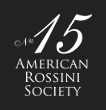Rossini in your living room with Maxim Mironov and Richard Barker

Some reflections on “This is Rossini”
Questo e Rossini!
Aria da camera, Illiria 2018
Maxim Mironov and Richard Barker
Available from www.illiria.de
The recently released CD featuring the artistry of tenor Maxim Mironov accompanied by pianist Richard Barker follows their previous collaboration devoted to Bellini. As with the earlier recording one of its joys is the musicianship these two artists share allowing for a seamless approach to the music.
The recording consists of 16 selections composed by Rossini under diverse circumstances
over a period of many years. Rossini’s non-operatic output was prodigious and the pieces here give some indication of their variety.
Some of these pieces will certainly be familiar and it is interesting to hear Mironov’s interpretation of them. “La Danza” which was a encore favorite of Pavarotti, gets a lighter, yet just as effusive treatment by Mironov. “Canzonetta Spagnuola” was one of the highlights of the concert from Versailles shown in the US on public television in 1985.
Marilyn Horne nearly stole the show at that time (which was quite an achievement considering the rest of the program) and here, too, Maxim gives a spirited, convincing interpretation.
We may have our favorites from the past, but it is refreshing and encouraging to be enchanted anew by these delightful performances.
Before going further we should note the essential contribution of Richard Barker. Not only is he a sensitive accompanist, but just imagine “Mi lagnero tacendo” or “ Adieux a la vie” without him. We won’t spoil it by revealing why it doesn’t work. You need to listen for yourself.
Passive listening is not appropriate for these works. They were after all intended to be heard in a salon or parlor where the audience was quite different from that in an opera house. Careful listeners may even be surprised; The line “Nell’Itale contrade” from “L’esule “ should resonate for non-Rossinian reasons.
Mironov has chosen to include the charming and humorous “La chason du bebe” which in addition to displaying some of Rossini’s humor demonstrates Mironov’s playful side.
There is another collaborator who should be mentioned, but this is only apparent when reading the printed material which is “included” with the CD, and that is the scholar Reto Muller who contributed commentary and research to this project.
While Mironov and Barker appeal directly to the senses, Muller enriches the experience with giving a min-history of aspects of Rossini’s activities that are not generally known.
The the casual Rossini fan may not be aware that Rossini was, in fact, an excellent singer ( although he didn’t appear in his own operas) and was an able pianist as well. Many of us would of course have loved to hear Colbran in “Armida”, but how amazing it would have been to hear Rossini and Colbran sing “Cara perte quest’ amima” from the same opera. There are other anecdotes as well for those who appreciate the cultural background. It seem Sarah Bernhardt herself inspired Rossini to improvise at the piano after she had declaimed a piece by Casimir Delavigne. Oh to have been at THAT gathering!
Much of the source material was provided by the Fondazione Rossini from their extensive collection of manuscripts. But mention must be made of the generosity of Sergio Ragni whose personal trove of Rossini treasures is unparalleled.
There is no insert with the notes included with the CD. Mironov has expressed on social media his desire to “save trees” which is worthy. Instead there is a digital libretto ( and notes) available using the QR code in the CD case. It would have been useful to have a link for those who don’t use a QR reader so that they might download the libretto/booklet from the internet.
The case and notes are decorated with whimsical drawings but are perhaps a tad dark for people with less than perfect eyesight.
All of these are minor quibbles and in no way detract from this wonderful contribution to the Rossini discography We do have a request. Next time it would be wonderful if Mironov would comment on why he made the choices he did. They are excellent and they would allow us to better know the artist behind the voice.


